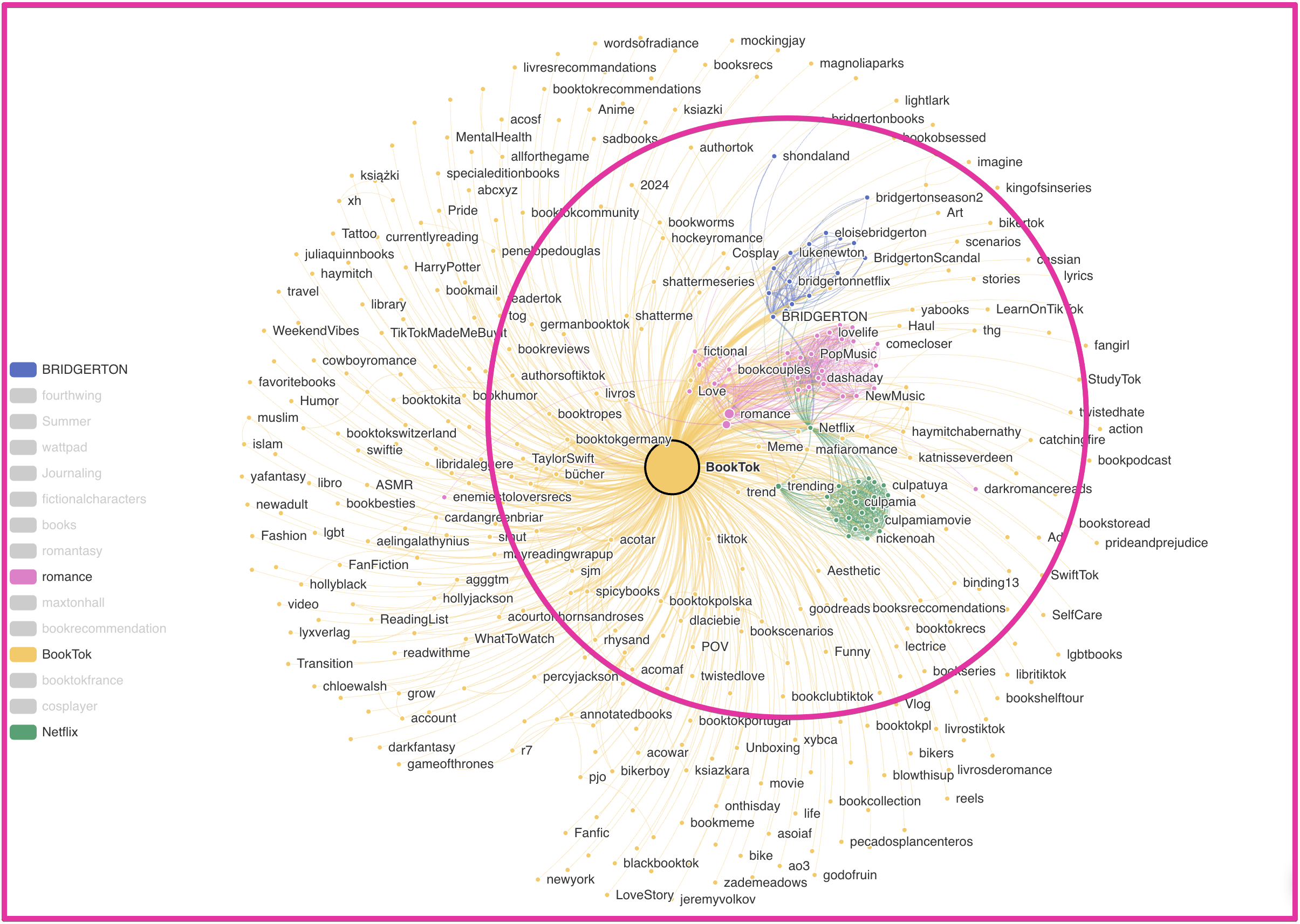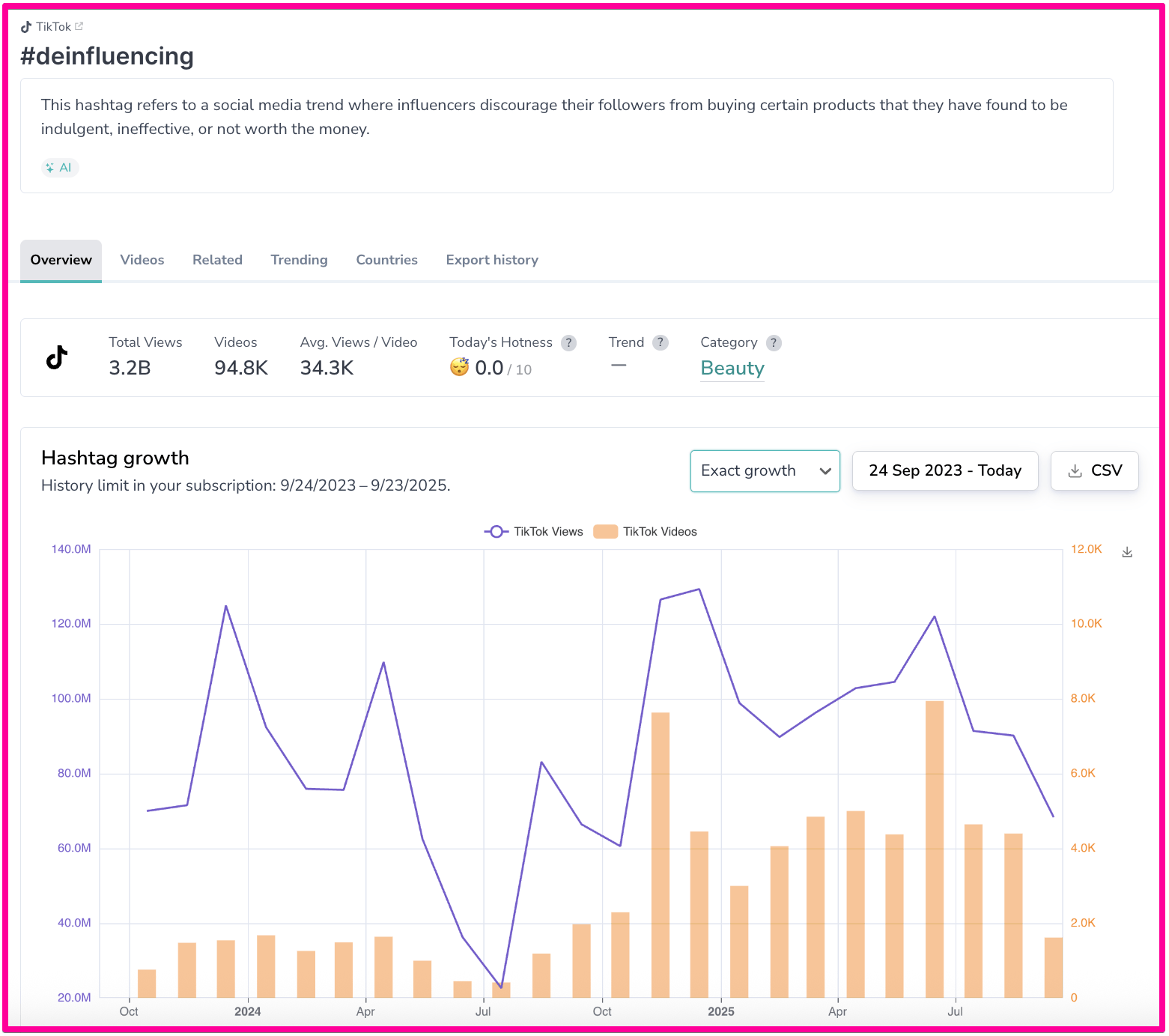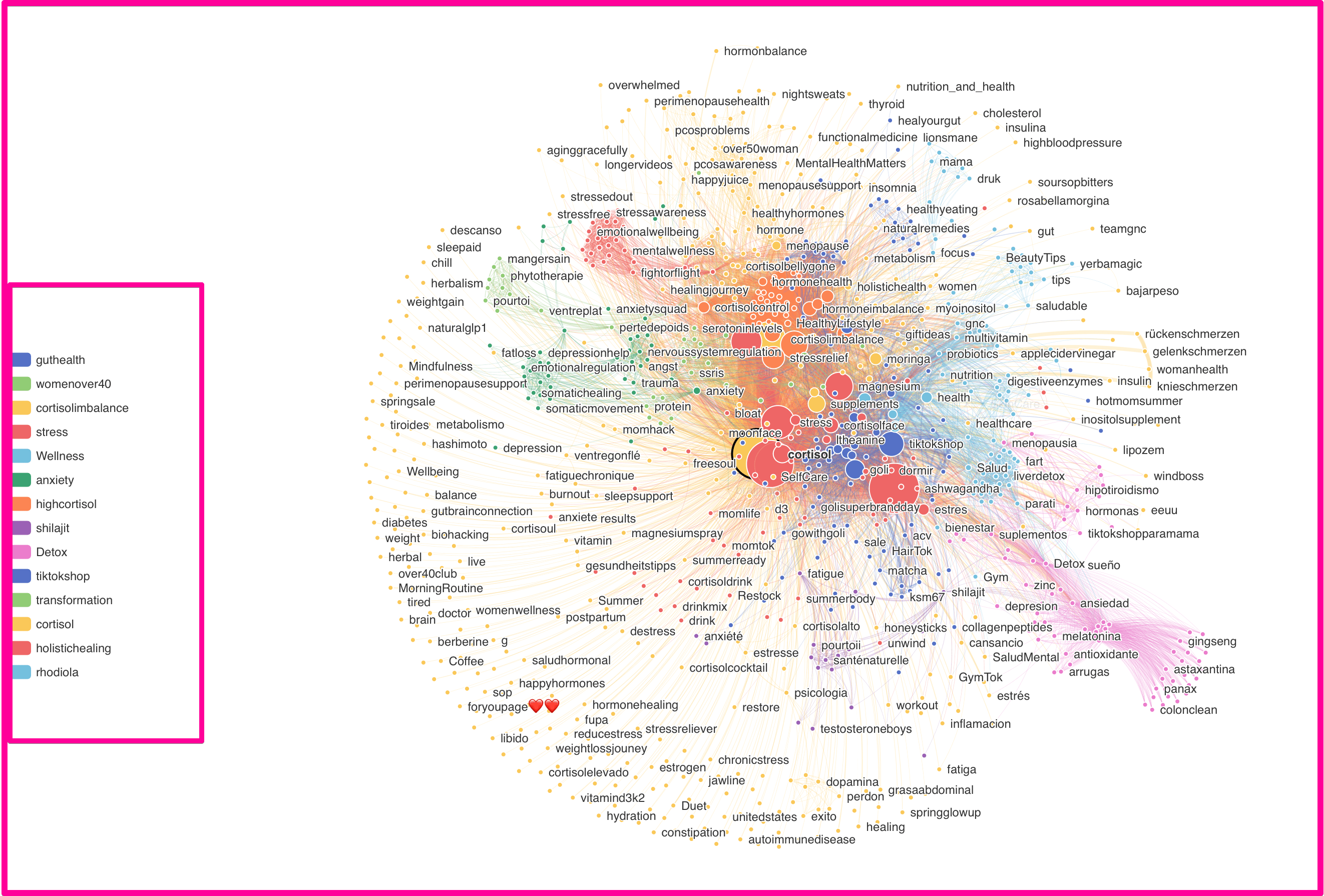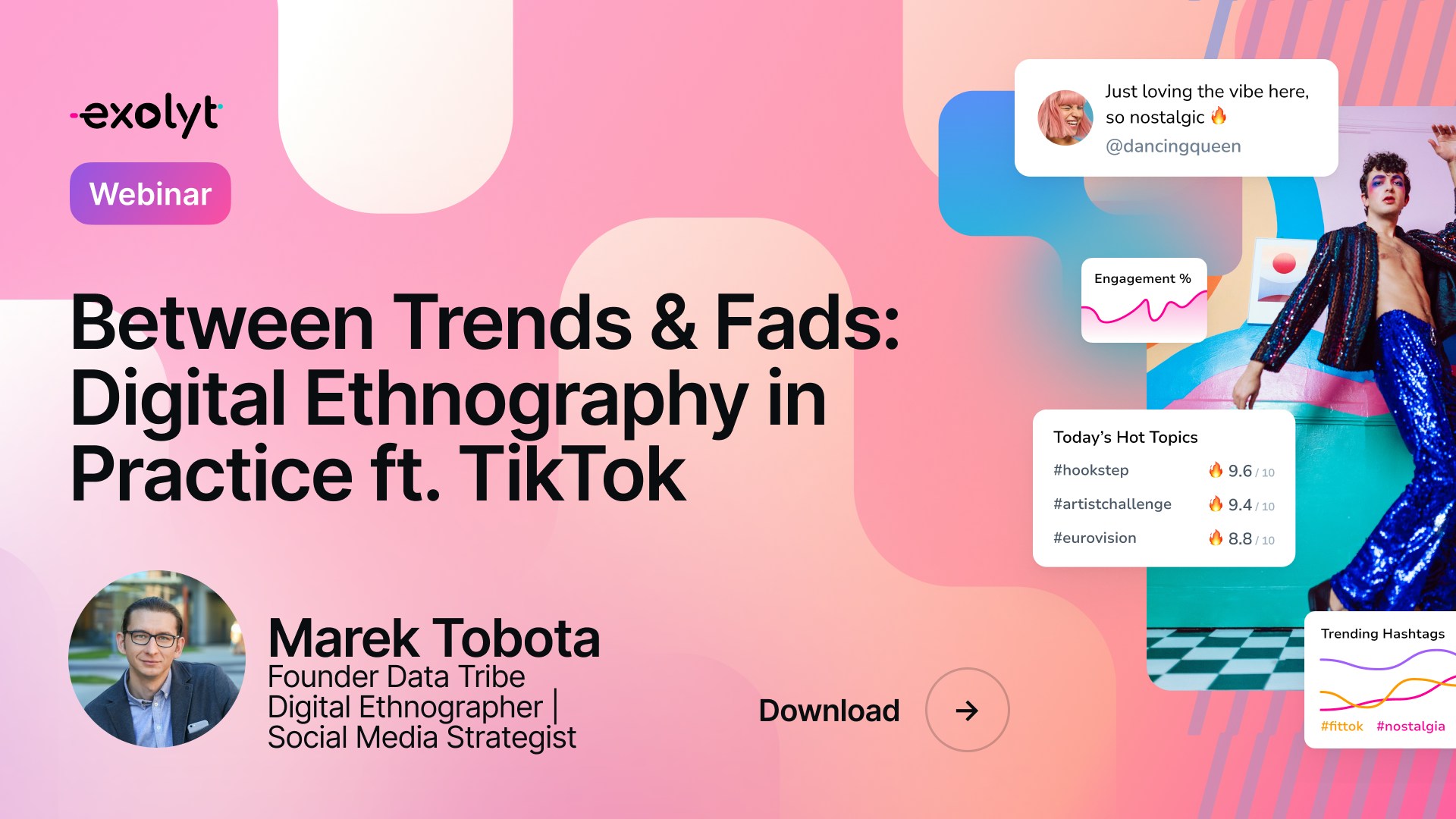Sisällysluettelo
TikTokin nopealiikkeisessä maailmassa on helppo sekoittaa ohimenevä viraalinen hetki merkitykselliseen trendiin. Useimmat brändit jahtaavat innokkaasti kaikkea, mikä on ”trendaavaa” sosiaalisessa mediassa, mutta menettävät siinä samalla usein käsityksen siitä, mitä todelliset trendit oikeasti tarkoittavat. Kyllä, osallistuminen viraalisiin TikTok-haasteisiin tai meemeihin voi tuottaa lyhytaikaista sitoutumista. Trendaavat hetket ovat kuitenkin lyhytikäisiä – tämän päivän viraalitanssi tai hashtag saattaa unohtua ensi viikolla. Todellinen haaste (ja mahdollisuus) markkinoijille ja brändistrategeille on oppia erottamaan lyhytikäinen villitys nousevasta kulttuuritrendistä, joka viestii syvemmistä muutoksista kuluttajien asenteissa.
Trendaaminen vs. Trendi vs. Villitys: Miksi sillä on väliä
- Trendaava = se, mikä on näkyvissä pinnalla – algoritmiset huomiopiikit.
- Trendi = käyttäytymistä tai arvoja koskeva syvä ja pysyvä muutos.
- Villitys = nopeasti syttyvä, lyhytikäinen hurahdus, jolla on vähän pitkäaikaista merkitystä.
Vaikka nämä termit vaikuttavat lähes samankaltaisilta, niiden välillä on hienovarainen ero siinä, miten ne vaikuttavat käyttäytymiseen ja kulttuuriin, millä nopeudella ne saavat vauhtia ja miten nopeasti ne häviävät. Näiden erojen ymmärtäminen auttaa brändejä välttämään strategisia virheaskeleita – kuten kalliiden kampanjoiden lanseeraamista ilmiöihin, joiden on määrä haihtua.
Trendit vs. Trendaava: Nopea kulttuuri vs. Hidas kulttuuri
Jotta trendit voidaan erottaa pelkistä trendaavista aiheista, on hyödyllistä ymmärtää ero nopean kulttuurin ja hitaan kulttuurin välillä. ”Nopea kulttuuri” viittaa nopeasti muuttuviin, lyhytaikaisiin villityksiin, joita sosiaalinen media ja popkulttuuri ajavat, kun taas ”hidas kulttuuri” kattaa kulttuurin kestävämmät, syvemmät virtaukset, jotka kehittyvät pidemmän ajan kuluessa. TikTokin viraalivideot, hashtag-tunnisteet ja äänipätkät ovat nopean kulttuurin ruumiillistuma – ne syttyvät nopeasti ja usein hiipuvat yhtä nopeasti. Mutta näiden suosion nousujen alla voi piillä hitaan kulttuurin liikkeitä, jotka kestävät ja kasvavat ajan myötä.
Trendaava ≠ Trendi: Kuten sosiaalisen kuuntelun asiantuntija Kim Townend toteaa Exolytin artikkelissa, ”yksittäiset trendit opettavat meille hyvin vähän, mutta ajan mittaan tarkastellut trendaavat aiheet osoittavat meille kaavoja ja yhteisiä piirteitä.”
Toisin sanoen, yksi tällä viikolla räjähtävä TikTok-hashtag saattaa olla vain hetkellinen ilmiö, mutta jos havaitset samankaltaisten teemojen toistuvan kuukausien ajan tai eri yhteisöissä, saatat nähdä todellisen trendin kulttuurisessa mielessä. Pelkkä TikTokissa trendaavien asioiden seuraaminen ei riitä – meidän on yhdistettävä nuo viraalihetket laajempaan kuvaan hitaan kulttuurin voimista, jotka muokkaavat kuluttajien käyttäytymistä.
Esimerkiksi ”Cozy Culture” (kodikas kulttuuri) nousi TikTok-trendiksi, joka esitteli lohdullista estetiikkaa ja sisältöä (ajattele lämmintä valaistusta, mukavia peliasetuksia tai sesongin kurpitsamausteisia teemoja). Pinnallisesti ”kodikas” sisältö leviää viraalisti sesonkiaalloissa (nopean kulttuurin ilmiö). Kuitenkin kodikkuus vastaa myös kuluttajien kestävään haluun mukavuuteen ja nostalgiaan – hitaampaan kulttuuriseen muutokseen.
Lue lisää tästä kulttuurisesta ilmiöstä blogistamme: Miten sosiaalista kuuntelua käytetään kulttuuristen trendien tunnistamiseen?
Why Context Matters: Beyond the Fad and “Trendwashing”
On houkuttelevaa lähteä mukaan jokaiseen TikTokin villityksen, mutta niiden seuraaminen sokkona on riski. Meemiin tai tanssiintrendiin osallistuminen ilman kontekstia voi johtaa ilmiöön, jota sosiaalistrategi Marek Tabota kutsuu ”trendwashingiksi” – pinnalliseksi trendin kopioinniksi, jonka yleisö tunnistaa välittömästi epäaidoksi.
Kaikki haluavat ratsastaa TikTok-trendien aallonharjalla, mutta kulttuuristen signaalien omiminen ilman syvempää ymmärrystä kostautuu usein. Brändeille oppi on selvä: älä vain seuraa trendejä, ymmärrä ne. Trendaava hashtag tai ääniraita voi kertoa jostain suuremmasta kohderyhmäsi maailmassa – huumorin, arvojen tai tarpeiden muutoksesta – ja jos konteksti jää huomaamatta, todellinen oivallus menee ohi.

The Real Value: Cultural Insight Over Trendspotting
Tohtori Jillian Ney, SI Labin perustaja, muistuttaa: trendit osoittavat, mikä on pinnalla; kulttuurinen näkemys kertoo, miksi se puhuttelee—uskomukset, motivaatiot, identiteetin siirtymät. He suosittelevat kuuntelemaan metrikkoja syvemmältä: tutkimaan, mitä ilmiön kaava todella kertoo, kenen äänet pääsevät esiin (tai jäävät pois) ja miten algoritmit muokkaavat näkyvyyttä.
Tämä ei ole pelkkä siisti menetelmä—vaan tapa ajatella. Se tarkoittaa monimutkaisuuden omaksumista, epäselvyyden kanssa viihtymistä ja thick data -aineiston arvon ymmärtämistä (Tricia Wangin termi)—kontekstirikkaita kertomuksia sosiaalisen hälyn taustalta. Lähde.
Eugene Healey: Context is Everything
Eugene Healey muistuttaa: brändin verhoaminen viraaliestetiikkaan ei ole strategiaa – se voi tuntua ontolta. Guardianin esseessä hän toteaa, kuinka Z-sukupolven raaka, suodattamaton tyyli (esim. ”bedrotten”-postaukset) muuttui omaksi hiotuksi estetiikakseen – vailla todellista aitoutta. Ja kun brändit omaksuivat tämän ”raakana ja suodattamattomana” esiintymisen tyylin sosiaalisessa mediassa, mikään ei ollut vähemmän aitoa kuin monikansalliset yhtiöt, joiden markkina-arvo on miljardeja dollareita, teeskennellen olevansa kyllästyneitä teinejä, mutta tässä me nyt olemme. Hänen mukaansa aitouden ymmärtäminen vaatii kulttuurin tuntemusta ja seurantaa.
Vastaavasti hän jakoi Exolytin kanssa tehdyssä yhteistyöpostauksessa näkemyksensä TikTokin salamannopeiden sisältösyklien tuomista haasteista ja mahdollisuuksista. TikTokin algoritmi on muuttanut tapaamme kokea trendejä – vaikka kaikki tuntuu trendiltä, kaikkeen ei kannata investoida. Siksi trendejä ei pidä kohdella oikoteinä sitoutumiseen; jos ne eivät ole linjassa brändi-identiteetin kanssa, trendit tuntuvat laiskoilta, eivät ovelilta.
Tässä joitakin keskeisiä poimintoja hänen videostaan:
- 𝗧𝗶𝗲𝗱ä, 𝗺𝗶𝘁ä 𝘀𝗲𝘂𝗿𝗮𝗮𝘁
Jokainen trendaava hashtag tai viraalivideo ei signaloi todellista kulttuurista muutosta! On ratkaisevan tärkeää ymmärtää ero ohikiitävän hetken ja keskustelun välillä, joka voi potentiaalisesti muokata kuluttajien käyttäytymistä.
- Käytä työkaluja melun suodattamiseen
Eugene korostaa sosiaalisen kuuntelun työkalujen merkitystä. Esimerkiksi Exolyt seuraa ja kartoittaa aiheeseen liittyviä keskusteluja, mikä auttaa erottamaan merkitykselliset trendit ohimenevistä meemeistä.
- Kartoita trendien ekosysteemi
Kuten mainittu, ymmärtämällä, miten trendi liittyy laajempiin kategorioihin, brändit voivat kohdistaa viestintänsä ja resurssinsa tehokkaasti. On tärkeää tietää keskustelun kestävyydestä ennen resurssien sitomista siihen.
- Siirry reagoimisesta strategiseen toimintaan
Tunnistamalla syvemmät keskusteluverkostot brändit voivat tehdä tietoon perustuvia päätöksiä osallistumispaikoista, yhteistyökumppaneista ja pitkän aikavälin sisältöstrategioiden rakentamisesta.
Miten tunnistaa todellinen trendi (eikä sokeutua viraalille melulle)
Pysyvän trendin erottaminen yhden hitin ihmeestä vaatii strategisempaa, tutkimukseen perustuvaa lähestymistapaa. Sosiaalinen kuuntelu ja kulttuurianalyysi ovat avainasemassa. Alla on joitakin käytännön vaiheita ja kriteerejä, jotka auttavat erottamaan todellisen trendin siitä, mikä on vain trendikästä TikTokissa:
- Look for Cross-Community Connections:
A quick litmus test is to see how wide and diverse the engagement is. If a hashtag or theme pops up across multiple communities or subcultures on TikTok, it has broader significance. The more disparate groups that adopt a tag or meme over time, the more likely it is that it represents a cultural trend rather than a niche fad.
For example, if a fashion hashtag is used not only by fashionistas but also in music, gaming, and food content, it’s tapping into something culturally pervasive. In contrast, a trending topic confined to one small corner of TikTok might be gone next week.
Tip: Track a hashtag over a few months – trending fads will often burn out quickly, whereas a true trend will show up repeatedly and in varied contexts. You can also keep an eye on Exolyt Hashtag Relations Graph to understand if the sub-topics that build the momentum for the main trend appear in other related conversations, and how prevalent it is.

Source: Exolyt Hashtag Relations, eg, #BookTok
- Watch for Patterns and Common Themes:
Don’t just count views; look for recurring themes or aesthetics. Are you noticing similar vibes, messages, or visuals across different trending videos? Are certain slang terms, song clips, or styles popping up again and again? Patterns can signal a deeper movement. As one analyst notes, being very “online” and attuned to these nuances makes it easier to connect the dots and understand the bigger cultural shifts driving them.
For example, the prevalence of DIY, upcycled fashion hacks on TikTok might point to a larger trend of sustainability and anti-consumerism among youth – even if each individual video trend (thrift flips, closet tours, etc.) seems separate, they share a common value. So, look for commonalities in why people engage with certain content: is it about identity expression, nostalgia, rebellion, or community belonging? Those common threads hint at the underlying trend.
- Check Longevity and Multi-Platform Presence:
One hallmark of a genuine trend is that it sticks around and expands beyond a single platform. If something is hot on TikTok and you see echoes of it on Instagram, Twitter (X), YouTube, or in Google search queries, then it has legs beyond a passing TikTok fad. Conversely, if a phenomenon is only big on TikTok and pops up suddenly, it could be a flash in the pan.
Research how long the topic has been percolating: Has this topic or hashtag been around for more than a few weeks? Do interest spikes repeat seasonally or grow over time? A trend that has been building up steadily for a year (even with ups and downs) and still shows an upward trajectory is a strong candidate for a real cultural trend. Also, check if people are searching for it on Google or discussing it on Reddit – growing search volume or cross-platform chatter usually means the trend reflects a broader interest, not just an algorithmic TikTok fluke.

You can always refer to Exolyt for monitoring historical and current growth rate of any topic on TikTok. Exolyt's hashtag exact growth analysis provides an accurate count of how much a hashtag has grown in terms of views, posts, and engagement on a specific day overtime.
- Analyze the Why (Contextualize the Trend):
Once you’ve identified a potential trend, dive deeper to understand its context and drivers. This is where true social listening and analysis come in. Gather data on how the trend is discussed: What language do people use? What sentiments or motives are expressed?
Rather than relying solely on AI or dashboards to tell you the story, spend time qualitatively reviewing content – read comments, note user anecdotes, and observe how the trend evolves. Often, the richest insights come from seeing how users themselves interpret the trend. Group related content or conversations into themes to see the bigger picture (for example, are most people engaging in a TikTok trend for humor, or for solidarity, or as an act of creativity?).
By immersing yourself in the discussions, you can interpret not just what people are doing, but why they’re doing it that way. This context will tell you if the trend connects to a meaningful cultural narrative or if it’s just a quirky meme.
- Identify the Underlying Human Need or Behavior:
Every lasting trend is fueled by some underlying human desire, fear, or value. Ask: What need is this trend fulfilling? It could be the need for community (e.g., a hashtag that unites a subculture), for self-expression, for escapism, for authenticity, etc. Pinpointing this driver is crucial.
If you find that a TikTok micro-trend is driven by, say, a desire for body positivity or financial freedom or eco-consciousness, then you’re not just looking at one trend – you’re seeing part of a bigger cultural movement.
As trend researchers advise, understanding the behavior or unmet need that drives a trend helps you see how it fits into the broader cultural shifts. For example, the viral “#GirlDinner” trend (where users show minimalist snack-plate dinners) might seem like just a funny shareable concept, but underlying it could be a commentary on independent living or a rejection of formal meal norms – themes that connect to larger cultural conversations about lifestyle and self-care. Always connect the trend back to fundamental human stories.
You can also refer to this webinar by Marek Tobota to learn how to separate a fleeting viral moment from an emerging cultural trend that signals deeper shifts in consumer attitudes.
Throughout this process, social listening tools and analytics platforms can be invaluable. Manually keeping up with TikTok’s firehose of content is tough, but platforms like Exolyt are designed to help spot and track these trends.
For instance, Exolyt’s dashboard can show you which TikTok hashtags and sounds are trending in real time, and even highlight related hashtags or communities engaging with them. This makes it easier to validate if your “trend hunch” is really catching on widely or just in a bubble.
Remember, though, that tools provide the data — it’s up to you to add the cultural analysis on top. As one expert cautions, don’t just rely on AI to analyze the data for you with no input; you might miss the best insights that way. Instead, use the tools to gather information, then apply human curiosity and expertise to interpret the meaning.
From TikTok Fad to Cultural Trend: Examples in Action
Sometimes the difference between a fad and a trend becomes clear only in hindsight. Consider these cases:
- “Cortisol Matcha”: On the surface, just another viral wellness hack. In context, it signaled a deeper consumer trend: rising awareness of stress management and hormone health. The fad recipe was part of a broader health conversation.

Source: Exolyt - Cortisol Related Conversations on TikTok
- Patagonia’s Purpose-Led Strategy: Environmental activism is not a fad. Patagonia’s actions – from anti-consumption campaigns to consistent activism – show the power of aligning with enduring cultural values rather than transient aesthetics.
- Marimekko’s Digital Resurgence: On TikTok, Marimekko prints trended visually, but the brand capitalized by linking the spike to deeper cultural associations: Finnish heritage, sustainability, and joyful expression.
@marimekko Our Scandi friend @Pernille Rosenkilde on a dreamy summer stroll 🧡 #marimekko #unikko #ootd #ootdinspo #copenhagen #springoutfit #scarvesstyling
♬ CARNAVAL - Cavendish
These examples underscore that what’s trending on TikTok can indeed be a gateway to significant cultural insights – but only if we look beyond the surface. A trend gains power when it plugs into cultural currents (like comfort, authenticity, pride in identity, etc.), and brands that grasp those currents can respond in a way that feels genuine to audiences.
The Big Picture: Trendspotting with Cultural Insight
At the end of the day, separating a true trend from a transient craze is about keeping the big picture in focus. Marketers and strategists should remember that TikTok is a mirror of society as much as it is a source of entertainment. We live in an extremely fast-moving world, and it’s easy to get caught up in fast culture. But identifying the trends that have longevity and are worth your time and investment is more important than ever. In practical terms, that means using TikTok not just for trendy content, but as a window into your audience’s evolving culture.
By combining real-time social listening with a deeper cultural analysis, you can forecast which viral moments are harbingers of bigger shifts. This can inform everything from your content strategy to product development.
For instance, spotting a genuine trend early can help future-proof your marketing strategy or inspire a new product line, while also mitigating the risk of jumping on a bandwagon that leads nowhere. On the flip side, understanding where your focus topic fits in the cultural landscape – why people are really talking about it, how their behavior is changing, and what they expect from brands – lets you stay one step ahead of competitors in resonating with the audience.
In Conclusion, “what’s trending” is just the starting point.
The real value comes from connecting those spikes in attention to enduring cultural narratives. Trends don’t work in isolation; they are threads in a larger tapestry of social change. As a brand strategist or marketer, your job is to see the whole tapestry, not just the loudest thread. So the next time a TikTok craze catches your eye, enjoy it – but also ask, what is this really about?
By asking the right questions and leveraging social intelligence, you’ll separate the signal from the noise and turn viral hype into meaningful strategy. In a world of dashboards and data overload, this kind of qualitative, culturally informed insight is not just useful – it’s transformative for anyone looking to build campaigns with real impact.
Vie TikTok-analyysisi uudelle tasolle Exolytin avulla
Aloita ilmaisella 7 päivän kokeilulla tai keskustele tiimimme kanssa oppiaksesi lisää alustan toiminnoista ja sen mahdollisista käyttötavoista.




